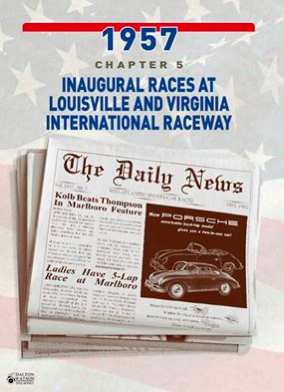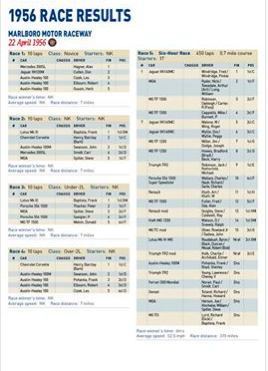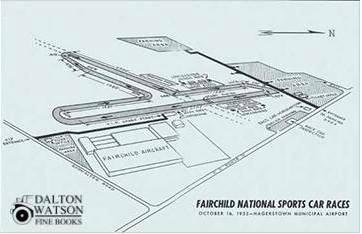By Terry O'Neil
Book background:The growth of sports car racing in the Mid-Atlantic States
of America was not a painless affair. Tragedy, mystery, intrigue and
conflicting interests between motor clubs all played their part in the 1950s
and early 1960s. Add to this the underlying trend of the better drivers towards
professionalism and it is evident that progress would come with its problems.
The Mid-Atlantic area of America was, due to its very nature
in being business and commerce orientated opposed to having an industrial base,
slower to become established than the neighbouring Northeast area.
New York and Jersey had the facilities to take the container
ships that unloaded the imported cars and it was of no surprise that the major
European motor manufacturers set up importers and car distributors in that
area.
The States of Maryland and Virginia were in no position to
challenge their northern neighbours, and sports car sales in particular were
mainly generated through military personnel of a certain rank coming back to
Washington and surrounding area.
Even though the Washington DC Region of the SCCA was growing
stronger as the decade progressed, the development of tracks for the sports car
enthusiasts was slow, and for certain individuals, very costly. Road
racing had never really figured in the Mid-Atlantic area in the early part of
the 50’s, and it was only when the SCCA began using the airfields at
Cumberland, Hagerstown and Andrews AFB that any momentum gathered pace.
The purpose made tracks at Marlboro and Virginia
International Raceway both experienced growing pains in an area where
oval-track racing was more a way of life for the general public. Wilmington,
Manassas and Richmond all held regular events, and the Marlboro and VIR
enterprises spent a great deal of money, trying to attract the public to their
tracks.
To add to these problems, the professional organisations,
NASCAR and SCODA were also active in the area, and a disruptive intervention
into sports car racing by USAC did little to help anyone. USAC promised much to
Marlboro and VIR but delivered little, making for a very tense relationship
with the SCCA. It also unsettled some of the better drivers who were thinking
of joining the professional ranks. It would come to light that some of these
individuals would in fact be better off staying as ‘amateur’ drivers.
The complex situation was to be resolved in a most
unexpected way as the 60’s arrived…..
Thanks to the help of the Washington DC Region of the SCCA,
and many of its individual members and enthusiasts, the author has, over the
past three years, managed to uncover an amount of documented and photographic
material. It enables the author to relate ten years of Mid-Atlantic motor
racing history from 1953 through to the end of 1962 in this book.
Signed, numbered Edition of 600 copies
- 392 pages
- 569 images
- Page size 240mm x 330mm
- ISBN: 978-1-85443-263-6
Click here to view sample pages.
Octane Magazine's Book Of The Month
July, 2015

Click here to view full size image.
Speedreaders.info review
2015
Nothing against the Miata—Spec Miata is the largest and most popular class within NASA these days (that other NASA, the National Auto Sport Association)—but this type of club racing is a far cry from the wild and wooly days of yore.
If you’re from Kentucky or North Carolina, this book has you covered too even if, strictly speaking, Mid-Atlantic means Delaware, Maryland, Virginia, West Virginia, and District of Columbia. While branching out west to include Kentucky’s one major circuit, Louisville, may be a bit of a stretch, looking south to North Carolina’s Winston-Salem and Raleigh tracks is an obvious choice because they were so fully integrated into the racing fraternity’s comings and goings.
 For people interested in the beginnings of sports car racing in the US, recent years have yielded—after years and decades of neglect—a rich crop of authoritative, definitive books that introduce into the record people, places, cars and results, consolidating what was scattered or obscure and saving it from perishing one day altogether. Neither the writers nor those they write about are getting any younger and it is an interesting phenomenon that enough willing and able scribes find themselves at a point in life where their availability coincides with advances in computing power and digitization of records that makes at least some mountains scalable.
For people interested in the beginnings of sports car racing in the US, recent years have yielded—after years and decades of neglect—a rich crop of authoritative, definitive books that introduce into the record people, places, cars and results, consolidating what was scattered or obscure and saving it from perishing one day altogether. Neither the writers nor those they write about are getting any younger and it is an interesting phenomenon that enough willing and able scribes find themselves at a point in life where their availability coincides with advances in computing power and digitization of records that makes at least some mountains scalable.
O’Neil is a Brit but he comes by this quintessential American topic organically, having circled the wagons for years with important books about this crucial decade in which amateur racing morphed into pro racing, with all the attendant upheavals in terms of organization and execution.
Readers new to the subject of regional racing would be well advised to first read O’Neil’s third book, Runways and Racers: Sports Car Races Held on Military Airfields in America 1952–1954 because it goes into more Big Picture detail about how and why the amateur racing grew, in fact why it became a fully organized and now ubiquitous sport at all.
It is not coincidence that some of the significant examples of this current crop of books come from the same publisher, and that there is a family resemblance to their appearance and approach. Willem Oosthoek’s trilogy Sports Car Racing in the South covers the same era but a different area and while the two authors did not specifically work in tandem they did communicate about the north/south divide, which is naturally occurring demarcation point anyway and not just in geographic terms. That both author’s books look similar is thanks to sharing a designer. A very visible commonality is the graphic treatment of titles, the key difference being that O’Neil follows British convention in the day/month treatment (as well as British spellings throughout).
 If the Mid-Atlantic region is not “your” area, realize that its different dynamic and demographic (cf. less of an industrial base and more business- and commerce-oriented; fewer auto dealers and distributors) meant its racing activities developed differently (i.e. slower) than other areas. The oval track/Nascar/SCODA crowd didn’t exactly embrace them furrin cars or the folks that ran them and these political and economic factors clearly play a role.
If the Mid-Atlantic region is not “your” area, realize that its different dynamic and demographic (cf. less of an industrial base and more business- and commerce-oriented; fewer auto dealers and distributors) meant its racing activities developed differently (i.e. slower) than other areas. The oval track/Nascar/SCODA crowd didn’t exactly embrace them furrin cars or the folks that ran them and these political and economic factors clearly play a role.
The book progresses in chronological order, one year per chapter. Early on O’Neil makes the point that the suspicion towards cars that had sponsors or uncommonly well-heeled owners able to hire drivers giving them an unseemly advantage was nothing new, having first been raised already 60 years earlier.
Within each year, an overview of major developments leads into a discussion of specific events at varying levels of detail (read the Introduction to the book to understand O’Neil’s approach to what and how he covers it) and ends with tables of results for those races but on occasion also others that were too minor or too poorly documented to warrant coverage in the main text. A multitude of thoroughly captioned period illustrations, including maps  and race posters, ticket stubs etc. give testament to a distinctly different time, fairly exotic machinery (from the obscure [Siluro-Crosley, Revis, Merlyn] to the unexpected [Karmann Ghia, Simca] to the inevitable [Maserati, Ferrari, Jaguar, Porsche]) and every now and then you’ll recognize a prominent, often international driver that already had done or would go on to great things.
and race posters, ticket stubs etc. give testament to a distinctly different time, fairly exotic machinery (from the obscure [Siluro-Crosley, Revis, Merlyn] to the unexpected [Karmann Ghia, Simca] to the inevitable [Maserati, Ferrari, Jaguar, Porsche]) and every now and then you’ll recognize a prominent, often international driver that already had done or would go on to great things.
In an earlier review we lamented the fact that tables or other data sets utilized acronyms whose meaning is not universally clear; this time there’s a legend. The Indeces are impressively deep. In every regard this is a worthy and worthwhile and important book; its run is limited to 600 signed and numbered copies.
O’Neil has already covered the Northeast, Martin Rudow attended to the Pacific Northwest, Mike Martin wrote the definitive USRRC book, Dick Wallen and cohorts have a number of pertinent offerings but quite different in scope and execution—which means the Mid-West is missing. O’Neil has that on his to-do list but first comes a book about sports car racing at Thompson Speedway and Raceway up to 1967.
Copyright 2015, Sabu Advani (speedreaders.info).


 Mid-Atlantic American Sports Car Races 1953-1962.
Mid-Atlantic American Sports Car Races 1953-1962. 



